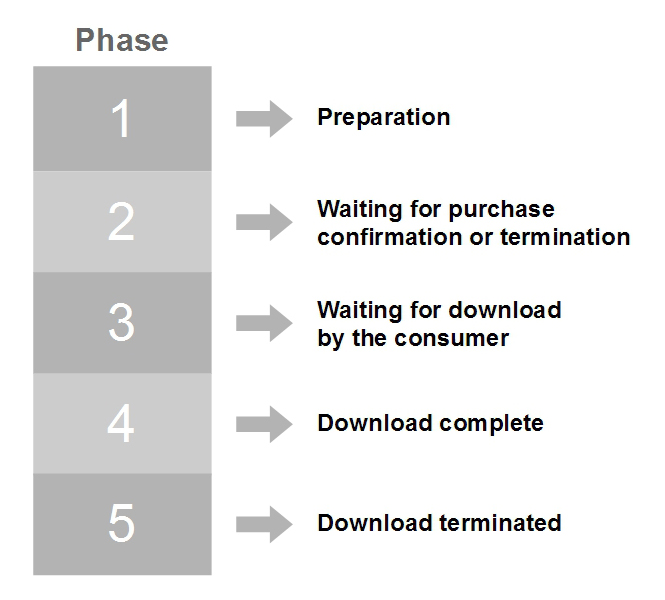Internet protocol (AODP)
Details and backgrounds
Phases of the AODP protocol
Every single purchase of an item carried out by a dealer's system (client) at a supplier's system (server) is carried out in a unique transaction, which at every time resides in one of five possible phases, controlled by client requests.

Starting with phase 1, a new transaction is opened. If it is accomplished without error the client can assume the requested digital item is available and may be delivered to the requesting dealer.
Phase 2 is supposed to assure that the physical file can actually be delivered. This is important in case the supplier's server has to create an individual file for every transaction. By signaling phase 2 the server guarantees that the file has been created and is ready to be delivered. This mechanism ensures that all multiple items of various suppliers in a consumer's shopping basket are ready for download before the consumer commences payment.
By requesting phase 3, the client commits the purchase and receives hereupon the download link (URL) from the server. The link is passed on to the consumer through the shop system. The download itself can now be started by the consumer.
Phase 4 starts after the first complete download was carried out. The client may check this at any time by sending a status request.
Phase 5 signals that the maximum number of downloads has been exceeded or the download time has expired. In case of a complaint by the consumer the dealer may send a reactivation request to the server, unlocking the download again, if the supplier allows it.
What about the accounting between supplier and dealer?
Accounting between supplier and dealer is done on their own discretion, as it is with physical products. This may take place on the fly while the transaction is executed or later on block, f.i. by normal invoicing. Accounting is actually no part of the protocol but may be automated in the transition to phase 3. As there is a unique numbering system for participants, items and transactions there is a common base for accounting data exchange. For instance every transaction can by identified on both sides by it's unique transaction ID.
AODP from a technological point of view
Technically, the internet protocol is based on existing internet standards. It uses XML-formatted messages which are exchanged via HTTP. However, AODP does not employ any HTTP specific functionality and is, thus, independent from its transport medium. For encryption/authentification SSL/TLS is used.
AODP for Your Industry
AODP, the new decentralized method for digital sales will initially be implemented in the printed music industry. AODP and the concept behind it
can both be technically implemented in all kinds of industries selling digital articles, e. g. Music, books, software, newspapers, etc.
Thus, the AODP service will be suitable for a wide variety of industries in the future.
» more
A virtual connection for trading partners
In the context of the NNND project, an internet protocol called "Automatic Ordering and Delivery Protocol" –
AODP in short – was developed.
It controls the process of communication between supplier, retailer and consumer. Orders and delivery of digital
products can go on decentrally, automatically and safely via AODP.
» more
The typical process of the internet protocol
During a sale via the internet protocol, two separate transactions take place, one between consumer and retailer and the other
between retailer and supplier. The business structure between retailer and consumer with AODP does not change. New is the
protocol's regulation of the simultaneous interaction between retailer and supplier. The entire communications process takes
place automated and lasts only a few milliseconds.
» more



